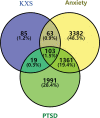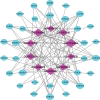Exploring the potential mechanism of Kaixinsan powder for the same pathogenesis of PTSD and anxiety based on network pharmacology and molecular docking: A review
- PMID: 37986356
- PMCID: PMC10659655
- DOI: 10.1097/MD.0000000000035869
Exploring the potential mechanism of Kaixinsan powder for the same pathogenesis of PTSD and anxiety based on network pharmacology and molecular docking: A review
Abstract
Background: Post-traumatic stress disorder (PTSD) and anxiety are common mental illnesses and there are many similar pathogenesis and clinical manifestations between PTSD and anxiety. Kaixinsan powder (KXS), a commonly used prescription in traditional Chinese medicine, has been widely used to treat PTSD and anxiety. This study aims to explore the potential mechanisms of KXS for the same pathogenesis of PTSD and anxiety using a network pharmacology approach.
Methods: The bioactive components and relevant target genes of KXS were obtained from the database about Traditional Chinese Medicine. The key genes of PTSD and anxiety were derived from disease databases. Subsequently, the network of protein-protein interaction and a network of "drug-components-disease-targets" was constructed. In order to treat PTSD and anxiety, gene ontology enrichment and signaling pathway enrichment were analyzed by using R language and components-core targets associated were validated by molecular docking.
Results: One hundred three targets of KXS in treating PTSD and anxiety were identified. The results of protein-protein interaction analysis and molecular docking indicated that AKT1 and IL-6 were crucial targets. Moreover, KEGG analysis has shown that neuroactive ligand-receptor interaction, calcium signaling pathway, and cAMP signaling pathway may play crucial roles in treating PTSD and anxiety. Ten biological process, 10 molecular function, and 10 cellular component were revealed via gene ontology analysis.
Conclusions: The network pharmacology study and molecular docking indicated that KXS treated anxiety and PTSD by multiple components, targets, and signaling pathways. These results provide an important reference for subsequent basic research on PTSD and anxiety.
Copyright © 2023 the Author(s). Published by Wolters Kluwer Health, Inc.
Conflict of interest statement
The authors have no conflicts of interest to disclose.
Figures

















Similar articles
-
[Study on mechanism of Valerianae Jatamansi Rhizoma et Radix against post-traumatic stress disorder based on molecular docking and network pharmacology].Zhongguo Zhong Yao Za Zhi. 2021 May;46(10):2380-2391. doi: 10.19540/j.cnki.cjcmm.20201229.401. Zhongguo Zhong Yao Za Zhi. 2021. PMID: 34047082 Chinese.
-
Network pharmacological investigation into the mechanism of Kaixinsan powder for the treatment of depression.Metab Brain Dis. 2022 Dec;37(8):2903-2914. doi: 10.1007/s11011-022-01067-5. Epub 2022 Sep 7. Metab Brain Dis. 2022. PMID: 36070047
-
A network pharmacology study with molecular docking to investigate the possibility of licorice against posttraumatic stress disorder.Metab Brain Dis. 2021 Oct;36(7):1763-1777. doi: 10.1007/s11011-021-00816-2. Epub 2021 Aug 21. Metab Brain Dis. 2021. PMID: 34417940
-
Systematic review of Kaixinsan in treating depression: Efficacy and pharmacological mechanisms.Front Behav Neurosci. 2022 Dec 6;16:1061877. doi: 10.3389/fnbeh.2022.1061877. eCollection 2022. Front Behav Neurosci. 2022. PMID: 36560929 Free PMC article.
-
Exploration of the mechanism of Zisheng Shenqi decoction against gout arthritis using network pharmacology.Comput Biol Chem. 2021 Feb;90:107358. doi: 10.1016/j.compbiolchem.2020.107358. Epub 2020 Aug 8. Comput Biol Chem. 2021. PMID: 33243703 Review.
References
-
- Watson P. PTSD as a public mental health priority. Curr Psychiatry Rep. 2019;21:61. - PubMed
-
- Auxéméry Y. Post-traumatic psychiatric disorders: PTSD is not the only diagnosis. Presse Med. 2018;47:423–30. - PubMed
-
- Shalev A, Liberzon I, Marmar C. Post-traumatic stress disorder. N Engl J Med. 2017;376:2459–69. - PubMed
-
- Williamson J, Jaffee M, Jorge R. Posttraumatic stress disorder and anxiety-related conditions. Continuum. 2021;27:1738–63. - PubMed
Publication types
MeSH terms
Substances
LinkOut - more resources
Full Text Sources
Medical
Miscellaneous

